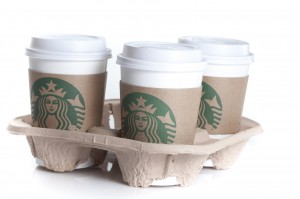With the appointment last month of its first Chief Technology Officer, this is perhaps not so straightforward to answer. As far back as 2010, Howard Schultz chairman and CEO gave an interview to Marketing Magazine outlining the company’s plans to become a leader in the digital space, stating that “social media is a natural extension of our brand because we want to do things that are unexpected and to speak to all sorts of people who are engaged in social media”.
Mobile payments now account for 21% of net transactions in U.S. company-operated stores, and this technology was only available in 7,500 of their 11,500 plus stores. They must be doing something right, when you compare it to US Department of Commerce figures of 7.2% eCommerce sales as percent of retail.
A focus on technological based innovation to drive loyalty and engagement and ensure on-going customer relevance (with the added benefit of super-sizing operational efficiency) has always been part of Starbucks’ strategy of promoting its stores as “the third place” – the other two being home and work. The place where you can hang out without being moved on, complete with comfortable chairs, music, free Wi-Fi and power outlets for laptops.
Pair this with their strategy of being wherever you are. They have a global network of 23,043 owned and franchised coffee stores across 68 countries, with an almost inescapable concentration in high wealth and traffic neighbourhoods in cities around the world. Seoul is the most Starbucks-filled city in the world with 284 locations, followed by New York at 277, then Shanghai at 266 and London at 202.
Despite fluctuating coffee prices and strong competition the company managed to post record fiscal results last week, with impressive revenues ($19.2 billion up 17% FY14), high margins (GAAP 18.8%) and increased customer traffic (3%). The financial markets agree; stocks have risen more than 60% since January 2014.
But what have they been doing that has led to this extraordinary growth?
New digital based ordering and delivery systems
Following a successful phased launch in the US of Mobile Order & Pay, Starbucks made it available from last month nationwide and started its international rollout in London, UK and Toronto, Canada. Mobile Order & Pay allows Starbucks customers to order in advance via an app and pick up their order from their chosen location, thus eliminating queues and making coffee-to-go even more convenient.
Payments are made through the Starbucks loyalty card, which creates operational efficiency as it reduces credit card costs and rewards the customer. The technology frees up more employees towards production and enables faster execution of orders.
Last month, a new pilot project designed for a dense urban environment was launched in the Empire State Building in New York; Green Apron Delivery service. The 12,000 people working there can order food and beverages from a select menu via a dedicated website. The orders are then prepped in a designated kitchen in the building and delivered to an agreed drop off location. Another project with courier delivery service, Postmates, was announced earlier this year.
New retail concepts – seeking unique ways and places to connect with customers
Starbucks has launched a wide range of novel concepts over the last few years, from its store on a Swiss train, to a mobile shop serving university campuses in the US, to the Express format store opposite the New York Stock Exchange.
Most recent is the Reserve Roastery and Tasting room in Seattle, aimed at enriching the experience of coffee lovers by providing them a 15,000 square foot space as a site for small batch roasting of premium coffee lines. Specialist Starbucks Reserve only Stores have been popping up all over the world from Taiwan to London to Mexico City, and feature the more expensive Reserve coffees. Each of these stores has been designed to act as a theatre in order to showcase an experiential coffee experience.
New partnerships that enhance the customer experience
These include collaborations with Spotify and Apple Music, an attempt to create a next generation music ecosystem. Wireless charging in stores is also being trialled in the US, thanks to a partnership with Duracell Powermat — sure to become a big draw for many customers.
New loyalty programs to reward customers based on their cultural preferences
Touted as the model loyalty program, Starbucks’ loyalty program spans 28 countries and is customised for each. For instance, in China it relies on gamification to drive participation, whilst the UK program has the highest threshold to top-tier benefits but many more “soft benefits,” such as free add-ons like shots and flavours. Meanwhile, the US is the only market where Starbucks uses email targeting for promotions and offers.
New innovation methods
‘MyRewardsIdea’ was created as a crowdsourcing community website in 2008 to collect ideas, suggestions and feedback from customers. Other users comment and vote on the ideas, and Starbucks informs them once they have launched. Starbucks also pilots its most innovative ideas across three stores in Seattle which Schultz describes as the company’s “laboratory.” The notion of selling alcohol was first tested here.
Starbucks’ ability to gain and keep customer attention through innovative reward programs and game changing concepts has been key to driving its growth — what lessons can we learn to accelerate our own growth initiatives?



